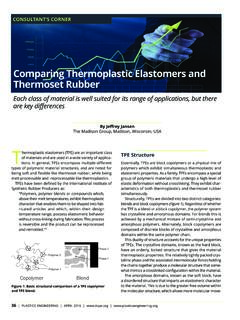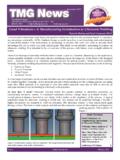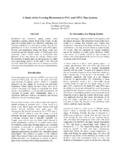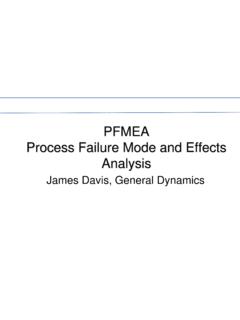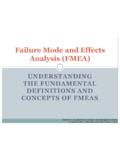Transcription of Characterization of Plastics in Failure Analysis
1 Characterization of Plastics in Failure Analysis Jeffrey A. Jansen, Stork Technimet, Inc. Now with The Madison Group THE ULTIMATE OBJECTIVE of a Failure in concert to determine the performance prop- limited quantitative, information regarding the Analysis is to ascertain the mode and the cause erties of a plastic component. This is represented composition and state of the material evaluated. of the Failure , regardless of the material from graphically in Fig. 2 (Ref 1). Fourier transform infrared spectroscopy uses in- which the part was fabricated. The investigation The principal differences between how Failure frared energy to produce vibrations within the is performed in generally the same manner, analyses are performed on metal and plastic ma- molecular bonds that constitute the material whether the failed component was produced terials center on the techniques used to evaluate evaluated. Vibrational states of varying energy from metal or plastic or a combination of these the composition and structure of the material.
2 Levels exist in molecules. Transition from one materials. Thus, the general steps required to Unlike metals, polymers have a molecular struc- vibrational state to another is related to absorp- conduct a comprehensive Failure investigation ture that includes characteristics such as molec- tion or emission of electromagnetic radiation are the same, and these are outlined in Fig. 1. In ular weight, crystallinity, and orientation, and (Ref 3). These vibrations occur at characteristic general, the Failure Analysis process is analogous this has a significant impact on the properties of frequencies, revealing the structure of the sam- to putting together a jigsaw puzzle. A Failure the molded article. Additionally, plastic resins ple. Fourier transform infrared spectroscopy pro- Analysis requires assembling bits of information usually contain additives, such as reinforcing duces a unique spectrum, which is comparable into a coherent and accurate portrayal of how and fillers, plasticizers, colorants, antidegradants, to the fingerprint of the material.
3 It is the prin- why the part failed. Reaching the objectives of and process aids. It is this combination of mo- ciple analytical technique used to qualitatively lecular structure and complex formulation that identify polymeric materials. the plastic Failure Analysis , namely, the deter- mination of the mode and cause of the Failure , requires specialized testing (Ref 2). While the or expressed alternatively, evaluating how the chemical composition of a failed metal compo- Method part failed and why it failed, requires a scientific nent can often be evaluated using a single spec- approach and a broad knowledge of polymeric troscopic technique, a similar determination re- Several different sampling techniques, all in- materials. quires multiple analytical approaches for a part volving either transmission or reflection of the Plastic components can fail via many different produced from a plastic resin. infrared energy, can be used to analyze the sam- modes, including catastrophic mechanisms, such This article reviews those analytical tech- ple material.
4 This allows the evaluation of ma- as brittle fracture, ductile overload, creep rup- niques most commonly used in plastic compo- terials in all forms, including hard solids, pow- ture, environmental stress cracking, molecular nent Failure Analysis . The description of the tech- ders, liquids, and gases. Depending on the degradation, and fatigue. In the case of Failure niques is not designed to be a comprehensive spectrometer and the corresponding accessories, review and tutorial but instead is intended to most samples can be analyzed without signifi- involving fracture, the determination of the fail- make the reader familiar with the general prin- cant preparation or alteration. In the Analysis of ure mode involves identifying how the crack ini- polymeric materials, transmittance, reflectance, tiated and how it subsequently extended. This is ciples and benefits of the methodologies. The de- and attenuated total reflectance (ATR) are the usually ascertained using a number of visual- scriptions of the analytical techniques are sup- most common sampling techniques.
5 Addition- based techniques, such as stereomicroscopy, plemented by a series of case studies. The ally, a microscope can be interfaced with the scanning electron microscopy (SEM), and the technique descriptions refer to the case studies, spectrometer to focus the infrared beam and al- preparation of mounted cross sections. Nonca- and the two are written in a complimentary man- low the Analysis of samples down to 10 lm. Re- tastrophic Failure modes are also relevant, and ner to illustrate the significance of the method. gardless of the sampling technique, the beam of these include discoloration, distortion, and con- The case studies also include pertinent visual ex- infrared energy is passed through or reflected off tamination. Assessing the mode of the Failure is amination results and the corresponding images of the sample and directed to a detector. The ob- often not as difficult as establishing why the part that aided in the Characterization of the failures.
6 Tained spectrum shows those frequencies that the failed. Evaluating why the part failed usually re- material has absorbed and those that have been quires analytical testing beyond the visual-based transmitted, as illustrated in Fig. 3. The spectrum techniques. In many cases, a single cause cannot Fourier Transform can be interpreted manually, or more commonly, be identified, because multiple integrated factors Infrared Spectroscopy compared with voluminous library references may have contributed to the Failure . All of the with the aid of a computer. factors that affect the performance of a plastic Fourier transform infrared spectroscopy component can be classified into one of four (FTIR) is a nondestructive microanalytical spec- Results categories: material, design, processing, and ser- troscopic technique that involves the study of vice conditions (Ref 1). These factors do not act molecular vibrations (Ref 2).
7 The Analysis re- The results generated through FTIR Analysis independently on the component but instead act sults provide principally qualitative, but also are referred to as an infrared spectrum. The 438 / Tools and Techniques in Failure Analysis spectrum graphically illustrates the relative in- Uses of FTIR in Failure Analysis chanical, chemical resistance, and aging prop- tensity of the energy absorbed on the y-axis ver- erties, the use of the wrong resin can yield sus the frequency of the energy on the x-axis. Material Identification. Possibly the most detrimental results in many applications. Fourier The frequency of the energy can be represented important use of FTIR in Failure Analysis is the transform infrared spectroscopy is well suited for directly in microns (lm) or, more popularly, as identification of the base polymer used to pro- the identification of polymers having different reciprocal centimeters (cm 1) referred to as duce the sample.
8 The determination of the com- molecular structures, and this is illustrated in wavenumbers. The discrete spectral features position of the failed component is an essential Fig. 4. Confirming that the failed article was pro- present with a FTIR spectrum are known as ab- part of the investigation. Because different poly- duced from the specified material is the primary sorption bands. mers have a wide variation in their physical, me- consideration of the Failure analyst in assessing the cause of the Failure . Thus, FTIR is often the first analytical test performed during a plastic Failure Analysis . The use of FTIR in character- izing the composition of the plastic-resin base polymer is illustrated in examples 1, 4, 7, and 9. in this article. One area where FTIR is inade- quate is in differentiating between polymers hav- ing similar molecular structures, such as the members of the nylon family, and poly(ethylene terephthalate) and poly(butylene terephthalate).
9 In these cases, other techniques, such as differ- ential scanning calorimetry, must be used to aug- ment the FTIR results. Aside from the determination of the base poly- mer, FTIR is used to characterize other formu- lation constituents. Fourier transform infrared spectroscopic Analysis can provide information regarding the presence of additives and filler ma- terials. Due to the nonlinearity of infrared ab- sorptivity of different molecular bonds, it is not possible to accurately state minimum concentra- tion detection limits. However, it is generally considered that materials present within a com- pounded plastic resin at concentrations below 1% may be below the detection limits of the spectrometer. Given this restriction, it is likely that most major formulation additives, such as plasticizers, can be characterized, while low- level additives, including antioxidants, may go undetected. Given that FTIR is principally used for the Analysis of organic materials, its use in the evaluation of inorganic filler materials is somewhat limited.
10 However, some commonly used fillers, such as calcium carbonate, barium sulfate, and talc, produce unique, identifiable Fig. 2 Graphical representation of the four factors influ- Fig. 1 Steps for performing Failure Analysis . The steps are the same regardless of the material encing plastic part performance Characterization of Plastics in Failure Analysis / 439. absorption spectra. Example 6 in this article Environmental stress cracking, the synergistic Differential Scanning Calorimetry shows the Analysis of plastic-resin formulation effect of tensile stress while in contact with a constituents. chemical agent, is one of the leading causes of Differential scanning calorimetry (DSC) is a Contamination. Similar to its ability to iden- plastic Failure . The chemical agent responsible thermoanalytical technique in which heat flow is tify the plastic formulation constituents, FTIR is for the cracking may be identified using FTIR.



